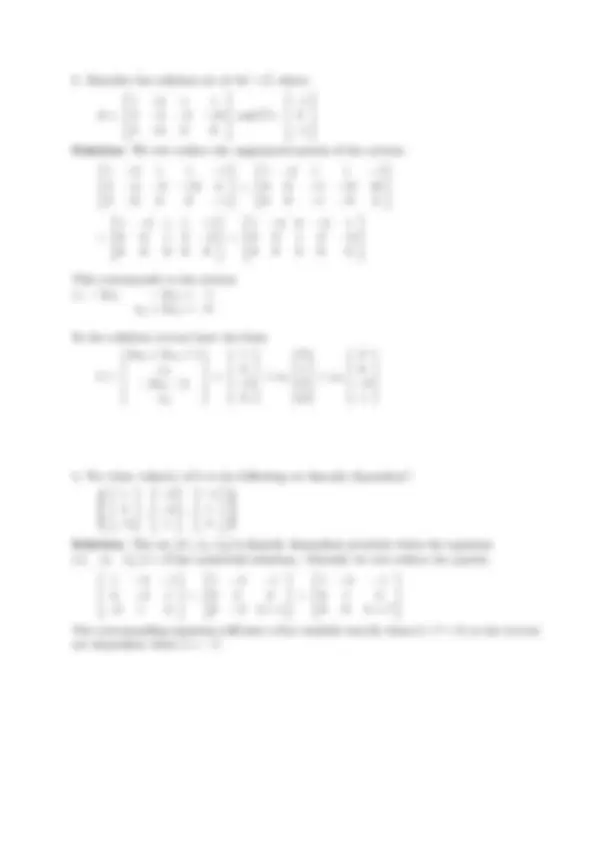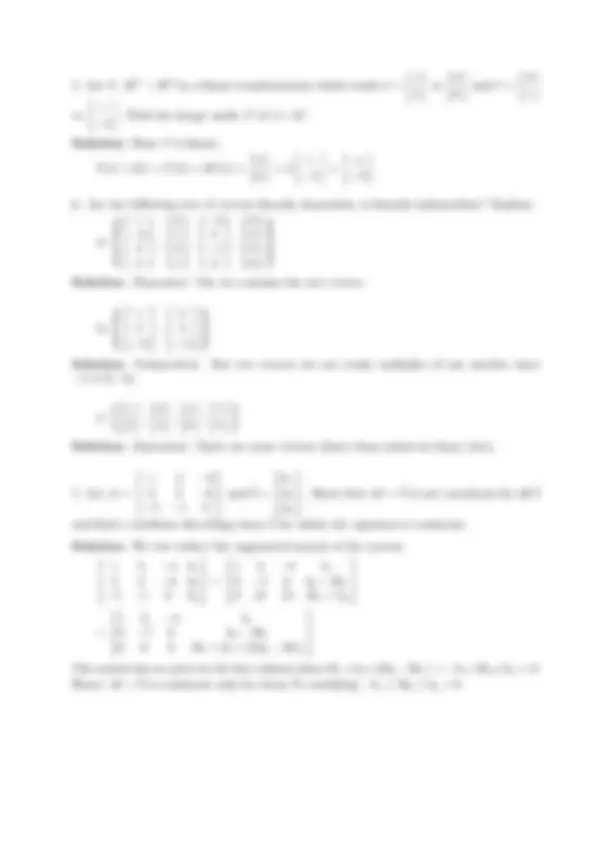




Study with the several resources on Docsity

Earn points by helping other students or get them with a premium plan


Prepare for your exams
Study with the several resources on Docsity

Earn points to download
Earn points by helping other students or get them with a premium plan
Community
Ask the community for help and clear up your study doubts
Discover the best universities in your country according to Docsity users
Free resources
Download our free guides on studying techniques, anxiety management strategies, and thesis advice from Docsity tutors
Material Type: Exam; Professor: Tingey; Class: Elem Linear Algebra; Subject: Mathematics; University: University of Oregon; Term: Unknown 1989;
Typology: Exams
1 / 4

This page cannot be seen from the preview
Don't miss anything!



False. If A =
, ~b =
, and ~c =
, then A~x = ~b is consistent, but A~x = ~c is not. T F If the augmented matrix [^ A ~b ]^ can be transformed by elementary row operations into reduced echelon form, then the equation A~x = ~b is consistent. False. Any matrix can be put in reduced row echelon form. The corresponding equation is consistent if there is no pivot in the last column. For example, if A =
and
~b =
, then [^ A ~b ]^ =
is already in reduced form, but has a pivot in the rightmost column, so A~x = ~b is inconsistent. T F If A is m × n and the equation A~x = ~b is consistent for every ~b in Rm, then A must have m pivot columns. True. If A~x = ~b is consistent for all ~b, then A has a pivot in every row. Hence, A has m pivots, so it has m pivot columns. T F If an m × n matrix A has m pivot columns then the equation A~x = ~b has a unique solution for every ~b in Rm. False. If A has more columns than rows, the equation will have a free variable. For example, the 2 × 3 matrix A =
has a pivot in every row, but A~x = ~0 has the infinite solution set {~x = (0, 0 , t) | t ∈ R}. T F If the set {~v 1 , ~v 2 , ~v 3 , ~v 4 } is linearly independent, then the set {~v 1 , ~v 2 , ~v 3 } is linearly independent. True. This is the same as saying that if {~v 1 , ~v 2 , ~v 3 } is linearly dependent, then {~v 1 , ~v 2 , ~v 3 , ~v 4 } is linearly dependent. This is straightforward: if c 1 ~v 1 + c 2 ~v 2 + c 3 ~v 3 = ~ 0 is a nontrivial dependence relation on {~v 1 , ~v 2 , ~v 3 }, then c 1 ~v 1 + c 2 ~v 2 + c 3 ~v 3 + 0~v 4 = ~0 is a nontrivial dependence relation on {~v 1 , ~v 2 , ~v 3 , ~v 4 }.
Fill in the blank If A is a 4 × 6 matrix and the transformation ~x 7 → A~x is onto, then A has 4 pivots and 2 free variables. [Onto says there’s a pivot in every row, so that’s 4 pivots and 6 − 4 = 2 free variables.]
If A is a 5 × 2 matrix and the transformation ~x 7 → A~x is one-to-one, then A has 2 pivots and 0 free variables. [One-to-one says there’s a pivot in every column, so that’s 2 pivots and 2 − 2 = 0 free variables.]
Problems
[ (^1 2) k 0 h − 8 5 − 4 k
(a) There is a pivot in the last column exactly when h = 8 and k 6 =^54.
(b) The equation has a unique solution if the coefficient matrix has a pivot in every column. This happens when h 6 = 8 (k can be anything).
(c) There are infinitely many solutions when the equation is consistent and has a free variable. Here that means a row of zeros. This happens when h = 8 and k =^54.
to
and ~v =
to
. Find the image under T of ~u + 2~v.
Solution: Since T is linear,
T (~u + 2~v) = T (~u) + 2T (~v) =
a)
Solution: Dependent. The set contains the zero vector.
b)
Solution: Independent. The two vectors are not scalar multiples of one another since − 5 6 = 2(−3).
c)
Solution: Dependent. There are more vectors (four) than entries in them (two).
(^) and ~b =
b 1 b 2 b 3
. Show that A~x = ~b is not consistent for all ~b
and find a condition describing those ~b for which the equation is consistent. Solution: We row reduce the augmented matrix of the system
1 3 − 4 b 1 3 2 − 6 b 2 − 5 − 1 8 b 3
1 3 − 4 b 1 0 − 7 6 b 2 − 3 b 1 0 14 12 5 b 1 + b 3
1 3 − 4 b 1 0 − 7 6 b 2 − 3 b 1 0 0 0 5 b 1 + b 3 + 2(b 2 − 3 b 1 )
The matrix has no pivot in the last column when 5b 1 +b 3 +2(b 2 − 3 b 1 ) = −b 1 +2b 2 +b 3 = 0. Hence A~x = ~b is consistent only for those ~b’s satisfying −b 1 + 2b 2 + b 3 = 0.